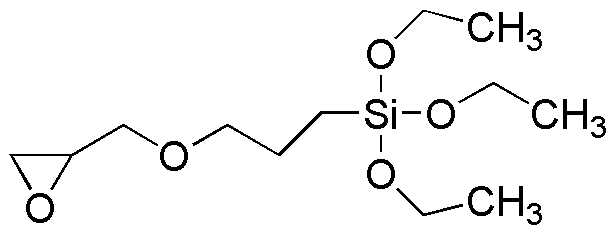(3-Glycidyloxypropyl)triethoxysilane is widely utilized in research focused on:
- Adhesives and Sealants: This compound enhances the adhesion properties of epoxy and silicone-based adhesives, making them ideal for construction and automotive applications.
- Coatings: It is used to improve the durability and chemical resistance of coatings in industrial settings, providing long-lasting protection for surfaces.
- Composite Materials: The chemical acts as a coupling agent in composite materials, improving the bonding between organic and inorganic components, which is crucial in aerospace and automotive industries.
- Surface Modification: It is effective in modifying surfaces to enhance hydrophobicity or hydrophilicity, benefiting industries like textiles and electronics.
- Biomedical Applications: This compound is explored for use in drug delivery systems and tissue engineering, leveraging its biocompatibility and ability to form stable bonds with biological materials.
General Information
Properties
Safety and Regulations
Applications
(3-Glycidyloxypropyl)triethoxysilane is widely utilized in research focused on:
- Adhesives and Sealants: This compound enhances the adhesion properties of epoxy and silicone-based adhesives, making them ideal for construction and automotive applications.
- Coatings: It is used to improve the durability and chemical resistance of coatings in industrial settings, providing long-lasting protection for surfaces.
- Composite Materials: The chemical acts as a coupling agent in composite materials, improving the bonding between organic and inorganic components, which is crucial in aerospace and automotive industries.
- Surface Modification: It is effective in modifying surfaces to enhance hydrophobicity or hydrophilicity, benefiting industries like textiles and electronics.
- Biomedical Applications: This compound is explored for use in drug delivery systems and tissue engineering, leveraging its biocompatibility and ability to form stable bonds with biological materials.
Documents
Safety Data Sheets (SDS)
The SDS provides comprehensive safety information on handling, storage, and disposal of the product.
Product Specification (PS)
The PS provides a comprehensive breakdown of the product’s properties, including chemical composition, physical state, purity, and storage requirements. It also details acceptable quality ranges and the product's intended applications.
Certificates of Analysis (COA)
Search for Certificates of Analysis (COA) by entering the products Lot Number. Lot and Batch Numbers can be found on a product’s label following the words ‘Lot’ or ‘Batch’.
*Catalog Number
*Lot Number
Certificates Of Origin (COO)
This COO confirms the country where the product was manufactured, and also details the materials and components used in it and whether it is derived from natural, synthetic, or other specific sources. This certificate may be required for customs, trade, and regulatory compliance.
*Catalog Number
*Lot Number
Safety Data Sheets (SDS)
The SDS provides comprehensive safety information on handling, storage, and disposal of the product.
DownloadProduct Specification (PS)
The PS provides a comprehensive breakdown of the product’s properties, including chemical composition, physical state, purity, and storage requirements. It also details acceptable quality ranges and the product's intended applications.
DownloadCertificates of Analysis (COA)
Search for Certificates of Analysis (COA) by entering the products Lot Number. Lot and Batch Numbers can be found on a product’s label following the words ‘Lot’ or ‘Batch’.
*Catalog Number
*Lot Number
Certificates Of Origin (COO)
This COO confirms the country where the product was manufactured, and also details the materials and components used in it and whether it is derived from natural, synthetic, or other specific sources. This certificate may be required for customs, trade, and regulatory compliance.

